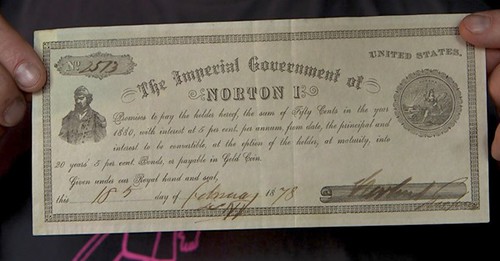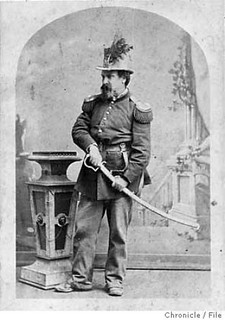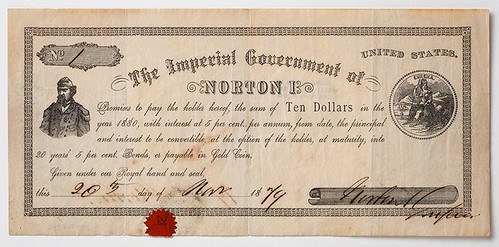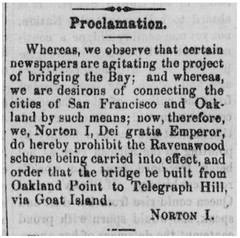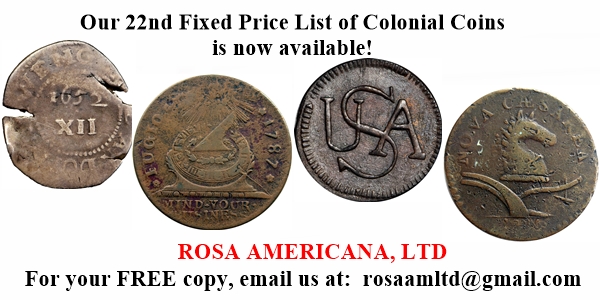
PREV ARTICLE
NEXT ARTICLE
FULL ISSUE
PREV FULL ISSUE
V25 2022 INDEX E-SYLUM ARCHIVE SAN FRANCISCO'S EMPEROR NORTONLevin Messick submitted some notes about San Francisco's Emperor Norton. Thanks. -Editor I enjoyed the article about General Sherman. He came to California during the days of '49. He was indeed a banker and he was forced by the Panic of 1857 to call in all loans in an attempt to save his bank. The attempt failed. Another failure was a certain Joshua Norton. He had attempted to corner the rice market in San Francisco. But a ship arrived in the harbor loaded with rice. So, Norton's scheme failed and Uncle Billy foreclosed on him and basically got nothing. So, Sherman went back east and Norton disappeared after suffering a mental breakdown. He would return, in 1860, as Norton I Emperor of the United States and Protector of Mexico. He would become a beloved "character" in San Francisco where he had an Imperial Box at the theatre and attended the openings of the State Legislature, in Sacramento, where he was provided a "throne". The "Big Four" railroad barons provided him a free pass for transit and railroad journeys. The city provided him a uniform and ceremonial sword. He corresponded with Queen Victoria, Presidents Lincoln, Jefferson Davis, and Benito Juarez, of Mexico. It was said that his funeral procession, in the 1880's was attended by ten thousand citizens. For banknote collectors it is an outstanding accomplishment to obtain a Norton Banknote. He issued Imperial notes to pay his way and they were accepted by virtually anyone in the city who received one. Today they are both rare and highly desired by obsolete currency collectors. Sherman, of course, would partner up with two other business failures named Lincoln and Grant to win the Civil War. Some years later when Sherman was asked why he had business dealings with a crazy man such as Norton; he is reported to have replied: "Well we were all a little crazy then" Norton had an Imperial request for the consideration of the Legislature. He desired that they should build a suspension bridge across the Golden Gate. A group out here called E Clampus Vitus has created a plaque for the Golden Gate Bridge that notes Norton's circa 1880 command to build it. Many SF residents have asked the powers that be to call it the Emperor Norton Bridge. So, we are all still a little crazy out here! LOL" Lev adds: "My wife attended Chapman University and had a history class with Professor "Killer Miller." He taught there 50 years. He was not noted for dispensing high grades. She did a paper on Norton for his class which put him over the Moon. He told her that none of his students had ever covered Norton before and she got an A." I'm a longtime Norton fan myself, having learned about him through numismatics - Norton issued those paper "bonds" to raise funds, and tourists to San Francisco were often buyers, having learned of him and his exploits through newspaper accounts. Our resident Norton expert is John Lumea of the Emperor Norton Trust. While much has been written about Norton over the years, separating fact from the considerable lore and fiction can be difficult. John kindly agreed to set some things straight for us. I've mangled many of these facts myself based on what I'd read over the years in the various books and articles about Norton. Some are minor points but all are worth correcting to keep the historical narrative on track. -Editor
"But a ship arrived in the harbor loaded with rice." Near-daily "Importations" lists published in the Daily Alta show that a succession of ships with rice cargoes large and small arrived in San Francisco in the days and weeks after Norton and his partners contracted to buy the Glyde's 200,000 lb. cargo on 22 December 1852. The momentary glut was cumulative — not based on one ship.
"So, Sherman went back east and Norton disappeared after suffering a mental breakdown. He would return, in 1860, as Norton I Emperor of the United States and Protector of Mexico." The language of "disappearance" and "return" is misleading. Norton's public profile did recede in the period following his declaration of bankruptcy in August 1856. But, it appears that he remained in San Francisco the whole time, and there is no evidence to suggest otherwise. Norton hand-delivered his Proclamation declaring himself Emperor to the San Francisco Daily Evening Bulletin on 17 September 1859 (not "in 1860"), and the Bulletin published the Proclamation in that evening's edition. The Emperor added "Protector of Mexico" in 1863, following Napoleon III's invasion of the country in late 1862 and subsequent installation of his puppet, Maximilian. For more on Norton's local activities in San Francisco between 1856 and 1859, see my recent article.
"He would become a beloved "character" in San Francisco where he had an Imperial Box at the theatre" There were many theaters in San Francisco. Although individual theater owners did seek to promote new shows by providing the Emperor with complimentary tickets, this was not a universal practice — and, I've never seen a reference to any theater having an "Imperial Box."
"... and attended the openings of the State Legislature, in Sacramento, where he was provided a "throne"."
"The city provided him a uniform and ceremonial sword." Apparently not. See my new article on this.
"He corresponded with Queen Victoria, Presidents Lincoln, Jefferson Davis, and Benito Juarez, of Mexico." There is some evidence that Emperor Norton tried to send telegraphs to these and other leaders. But, it seems that the "responses" the Emperor received were drafted and sent to him as pranks by the telegraph operators, who never sent his original messages.
"He issued Imperial notes to pay his way and they were accepted by virtually anyone in the city who received one." There is no evidence that this was anything like a universal practice. Emperor Norton's promissory notes served a variety of purposes. Occasionally, when the Emperor collected from business owners, bankers, lawyers and such the tributes that he called "taxes," he used the notes as receipts, suggesting that he regarded these "taxes" as investments in the Empire. He sold the notes in the streets to tourists and townsfolk alike, who purchased them primarily for the souvenir value of his signature. There appears to be no evidence that any of these people — "taxpayers," tourists or townsfolk — did anything with the notes other than to save them as mementos. Probably the only person who tried to spend them was Emperor Norton himself. Even then, the notes would have been accepted only by sympathetic proprietors who considered themselves friends or supporters of the Emperor — similar to saloon keepers who waved him through the free-lunch line without paying the one-drink fee, because (a) they had a soft spot for the Emp and (b) it was good for business to have him as part of the rotating cast.
"Norton had an Imperial request for the consideration of the Legislature. He desired that they should build a suspension bridge across the Golden Gate."
"A group out here called E Clampus Vitus has created a plaque for the Golden Gate Bridge that notes Norton's circa 1880 command to build it."
"Many SF residents have asked the powers that be to call it the Emperor Norton Bridge." Gratuitous promotion: 2022 is the 150th anniversary of Emperor Norton's "bridge Proclamations" of 1872. The Emperor Norton Trust is urging state lawmakers to use this once-in-our-lifetimes symbolic opportunity to simply add "Emperor Norton Bridge" as an honorary name for the San Francisco–Oakland Bay Bridge — leaving in place all existing names and signage for the bridge and its constituent parts ("spans," tunnel, etc.). Those interested in supporting this effort can go to EmperorNortonBridge.org, where they'll find button links to "Learn More" and "Sign the Petition." An excerpt from John's new article on Norton's uniform appears elsewhere in this issue. Thanks for sorting this out, John. We'll give you an "A+"!! -Editor Lev adds: "Well, I have no problem with corrections. Norton did attend the meetings of the State Legislature. Please note that "throne" was in quotation marks. It was a chair. With the "Emperor" sitting in it- it became a "throne". As to where he actually sat I have not seen any information anywhere on the exact spot! "He did have a lifetime railroad pass. Norton's net worth was given as $250,000.00 Circa 1853. That would be $8.2 Million in today's money. So, I think that most of the business men in SF who were not comatose (LOL) probably knew him very well. Further, another article pointed out that he actually held one or more railroad locomotive patents. These would of course have provided income. I have not had the time to research that information so it may or may not be true. Patents are public record but going back that far is time consuming. Something for me to do in the summer. "Now, there is a rather extensive article on Norton that was published in "Money Talks" pages 40-49. The book was published by the California State Numismatic Association, in 1970, and was edited by the late James L. Betton. The article by the late Fred Marckhoff, of Elgin, Illinois is, in some cases, at odds with other sources. It seems that the U.S. Army post in SF issued new brass buttoned and gold braided uniforms to the Emperor when his old ones wore out. "Mr. Marckhoff also noted the serial number runs of each note/bond printing and how many of each note were issued and actually used or not. This, of course does not indicate how many still exist.. Mr. Marckhoff does give very extensive information regarding Norton's birth, life in South Africa, life as a well known and respected businessman, in SF, and his business dealings as well as those of his business partners, and court proceedings, all dated and documented. Mr. Marckhoff pointed out that his business partners, in the rice fiasco, did not suffer any ill consequences due to faulty wording in the contract document. "Norton, like Daniel Boone and Davy Crockett was a real person who became a legend. He is one of California's most beloved and wonderful characters and like all such characters grows ever larger in the telling! Down here in Southern California we have Mickey Mouse, Bugs Bunny, and Wile e Coyote! They all have postage stamps! Maybe we could get Norton a commemorative coin." I, for one, would line up to buy an Emperor Norton commemorative coin. He was my kind of crazy, and I'd buy him a drink just to hang out and philosophize sometime. We should have an Emperor Norton impersonator at major coin shows - he could sell souvenir bonds and tokens to pay his expenses. Nothing like a little cosplay to liven things up, as we've already seen with Ben Franklin, Abe Lincoln and King Alanus of Bermania. -Editor
For more information, see:
To read earlier E-Sylum articles, see:
Wayne Homren, Editor The Numismatic Bibliomania Society is a non-profit organization promoting numismatic literature. See our web site at coinbooks.org. To submit items for publication in The E-Sylum, write to the Editor at this address: whomren@gmail.com To subscribe go to: https://my.binhost.com/lists/listinfo/esylum All Rights Reserved. NBS Home Page Contact the NBS webmaster 
|
